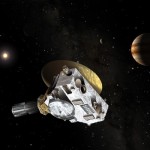The Next Mission After Rosetta: Osiris Rex
The OSIRIS-REx launch window opens on September 3, 2016. The launch period will last for 39 days, with a 30 minute window available each day. OSIRIS-REx will leave Cape Canaveral, Florida on an Atlas V rocket in the 411 configuration. Throughout the 39 days the characteristic energy (C3) is fixed at 29.3km2/s2, for a launch vehicle capability of 1955 kg.
The 411 configuration adds a single strap-on solid booster rocket to the first stage. The Atlas V rocket uses a Russian-built RD-180 engine burning kerosene and liquid oxygen to power its first stage, and an American-built RL10 engine burning liquid hydrogen and liquid oxygen to power its Centaur upper stage.
The fairing separates in preparation for the release of the spacecraft from the Centaur upper stage.
Arriving at Bennu
OSIRIS-REx is basically formation flying with Bennu during the asteroid encounter. Moving into position for sample acquisition late 2019, the total change in velocity is just over 20 cm/s (0.45 mph), miniscule compared to the large maneuvers required to arrive and depart from the asteroid vicinity. The encounter culminates in the touch-and-go maneuver at a velocity of 10 cm/s (0.22 mph), and collects the sample.
The Touch-And-Go Sample Acquisition Mechanism (TAGSAM) consists of a robotic arm with an attached sampler head.
RETURN MISSION
The window for departing Bennu opens in March 2021. At this time OSIRIS-REx will fire the main engines and leave Bennu with a speed of 0.32 km/s (716 mph). This burn will place OSIRIS-REx on a ballistic trajectory that intersects the orbit of the Earth in September 2023.
Some are speculating what exactly this whole mission is to serve, with keeping in mind the unique names chosen for this mission and the next asteroid to sample. Check out the video below for a detailed analysis:



